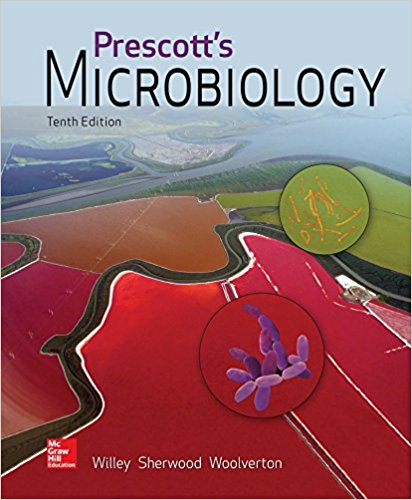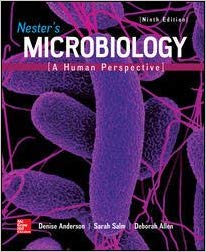Description
Test Bank For Prescotts Microbiology 10th Edition By Willey Sherwood Woolverton
Chapter 03
Bacterial Cell Structure
Fill in the Blank Questions
1. The genus of bacteria that undergoes cell division in random planes, forming grapelike clusters of round bacteria, are the __________.
staphylococci or
staphylococcus
ASM Objective: 02.01 The structure and function of microorganisms have been revealed by the use of microscopy (including bright field, phase contrast, fluorescent, and electron).
ASM Topic: Module 02 Cell Structure and Function
Blooms Level: 1. Remember
Learning Outcome: 03.02.01 Distinguish a typical bacterial cell from a typical plant or animal cell in terms of cell shapes and arrangements, size, and cell structures
Learning Outcome: 03.02.02 Discuss the factors that determine the size and shape of a bacterial cell
Section: 03.02
Topic: Bacteria
Topic: Bacterial Cellular Morphology
Topic: Gram-Positive Staphylococci
2. Bacteria that do not have a fixed shape are said to be __________.
pleomorphic
ASM Objective: 02.01 The structure and function of microorganisms have been revealed by the use of microscopy (including bright field, phase contrast, fluorescent, and electron).
ASM Topic: Module 02 Cell Structure and Function
Blooms Level: 1. Remember
Learning Outcome: 03.02.01 Distinguish a typical bacterial cell from a typical plant or animal cell in terms of cell shapes and arrangements, size, and cell structures
Section: 03.02
Topic: Bacteria
Topic: Bacterial Cellular Morphology
3. A branched network of hyphae formed by the Actinomycetes is called a __________.
mycelium
ASM Objective: 02.01 The structure and function of microorganisms have been revealed by the use of microscopy (including bright field, phase contrast, fluorescent, and electron).
ASM Topic: Module 02 Cell Structure and Function
Blooms Level: 1. Remember
Learning Outcome: 03.02.01 Distinguish a typical bacterial cell from a typical plant or animal cell in terms of cell shapes and arrangements, size, and cell structures
Learning Outcome: 03.02.02 Discuss the factors that determine the size and shape of a bacterial cell
Section: 03.02
Topic: Actinomycetes
Topic: Bacteria
Topic: Bacterial Cellular Morphology
4. Actinomycetes form long filaments called ___________.
hyphae
ASM Objective: 02.01 The structure and function of microorganisms have been revealed by the use of microscopy (including bright field, phase contrast, fluorescent, and electron).
ASM Objective: 02.03 Bacteria and Archaea have specialized structures (e.g. flagella, endospores, and pili) that often confer critical capabilities.
ASM Topic: Module 02 Cell Structure and Function
Blooms Level: 1. Remember
Learning Outcome: 03.02.01 Distinguish a typical bacterial cell from a typical plant or animal cell in terms of cell shapes and arrangements, size, and cell structures
Learning Outcome: 03.02.02 Discuss the factors that determine the size and shape of a bacterial cell
Section: 03.02
Topic: Actinomycetes
Topic: Bacterial Cellular Morphology
True / False Questions
5. Sterol-like molecules called hopanoids are thought to be important for the structural integrity of many bacteria because of their suspected role in membrane stabilization.
TRUE
ASM Objective: 02.03 Bacteria and Archaea have specialized structures (e.g. flagella, endospores, and pili) that often confer critical capabilities.
ASM Topic: Module 02 Cell Structure and Function
Blooms Level: 2. Understand
Learning Outcome: 03.03.01 Describe the fluid mosaic model of membrane structure and identify the types of lipids typically found in bacterial membranes
Learning Outcome: 03.05.01 Compile a list of the structures found in all the layers of bacterial cell envelopes, noting the functions and the major component molecules of each
Section: 03.03
Section: 03.05
Topic: Bacteria
Topic: Cellular Organization
Topic: External Bacterial Structures
6. The cell membrane is a rigid structure that provides bacteria with their characteristic shapes.
FALSE
ASM Objective: 02.03 Bacteria and Archaea have specialized structures (e.g. flagella, endospores, and pili) that often confer critical capabilities.
ASM Topic: Module 02 Cell Structure and Function
Blooms Level: 2. Understand
Learning Outcome: 03.02.02 Discuss the factors that determine the size and shape of a bacterial cell
Learning Outcome: 03.03.01 Describe the fluid mosaic model of membrane structure and identify the types of lipids typically found in bacterial membranes
Section: 03.02
Section: 03.03
Topic: Bacteria
Topic: Bacterial Cellular Morphology
Topic: External Bacterial Structures
7. Gram-positive bacteria have a thinner layer of peptidoglycan than gram-negative bacteria.
FALSE
ASM Objective: 02.01 The structure and function of microorganisms have been revealed by the use of microscopy (including bright field, phase contrast, fluorescent, and electron).
ASM Topic: Module 02 Cell Structure and Function
Blooms Level: 2. Understand
Learning Outcome: 03.04.01 Describe peptidoglycan structure
Learning Outcome: 03.04.02 Compare and contrast the cell walls of typical Gram-positive and Gram-negative bacteria
Section: 03.04
Topic: Bacteria
Topic: External Bacterial Structures
8. Gram-positive bacteria have a structurally and chemically more complex cell wall than gram-negative bacteria.
FALSE
ASM Objective: 02.01 The structure and function of microorganisms have been revealed by the use of microscopy (including bright field, phase contrast, fluorescent, and electron).
ASM Objective: 02.02 Bacteria have unique cell structures that can be targets for antibiotics, immunity and phage infection.
ASM Objective: 02.03 Bacteria and Archaea have specialized structures (e.g. flagella, endospores, and pili) that often confer critical capabilities.
ASM Topic: Module 02 Cell Structure and Function
Blooms Level: 2. Understand
Learning Outcome: 03.04.01 Describe peptidoglycan structure
Learning Outcome: 03.04.02 Compare and contrast the cell walls of typical Gram-positive and Gram-negative bacteria
Section: 03.04
Topic: Bacteria
Topic: Bacterial Cellular Morphology
Topic: External Bacterial Structures
9. Bacteria growing at lower temperatures have more saturated fatty acids in their membranes.
FALSE
ASM Objective: 03.02 The interactions of microorganisms among themselves and with their environment are determined by their metabolic abilities (e.g., quorum sensing, oxygen consumption, nitrogen transformations).
ASM Objective: 05.03 Microorganisms and their environment interact with and modify each other.
ASM Topic: Module 03 Metabolic Pathways
ASM Topic: Module 05 Microbial Systems
Blooms Level: 3. Apply
Learning Outcome: 03.03.01 Describe the fluid mosaic model of membrane structure and identify the types of lipids typically found in bacterial membranes
Section: 03.03
Topic: Bacteria
Topic: Bacterial Cellular Morphology
Topic: External Bacterial Structures
Multiple Choice Questions
10. Predict how the plasma membrane fatty acid composition would change as the temperature of the habitat of an aquatic bacterial species warms from 2oC to 15oC during the spring and summer months.
A. The percentage of saturated fatty acids would increase.
B. The percentage of unsaturated fatty acids would increase.
C. The percentage of saturated fatty acids would decrease.
D. The percentage of saturated fatty acids would remain unchanged.
ASM Objective: 02.03 Bacteria and Archaea have specialized structures (e.g. flagella, endospores, and pili) that often confer critical capabilities.
ASM Objective: 05.01 Microorganisms are ubiquitous and live in diverse and dynamic ecosystems.
ASM Objective: 05.03 Microorganisms and their environment interact with and modify each other.
ASM Topic: Module 02 Cell Structure and Function
ASM Topic: Module 05 Microbial Systems
Blooms Level: 4. Analyze
Learning Outcome: 03.05.01 Compile a list of the structures found in all the layers of bacterial cell envelopes, noting the functions and the major component molecules of each
Section: 03.05
Topic: Bacteria
Topic: Bacterial Cellular Morphology
Topic: External Bacterial Structures
Fill in the Blank Questions
11. When the cell wall is removed from a Gram-negative bacterium without removing the outer membrane, the resulting form is called a(n) __________.
spheroplast
ASM Objective: 02.01 The structure and function of microorganisms have been revealed by the use of microscopy (including bright field, phase contrast, fluorescent, and electron).
ASM Objective: 02.02 Bacteria have unique cell structures that can be targets for antibiotics, immunity and phage infection.
ASM Objective: 02.03 Bacteria and Archaea have specialized structures (e.g. flagella, endospores, and pili) that often confer critical capabilities.
ASM Topic: Module 02 Cell Structure and Function
Blooms Level: 2. Understand
Learning Outcome: 03.04.02 Compare and contrast the cell walls of typical Gram-positive and Gram-negative bacteria
Learning Outcome: 03.04.03 Relate bacterial cell wall structure to the Gram-staining reaction
Section: 03.04
Topic: Bacteria
Topic: Bacterial Cellular Morphology
Topic: External Bacterial Structures
12. Enzymes that are secreted out of the cell to aid in the acquisition and digestion of environmental nutrients are called __________.
exoenzymes
ASM Objective: 03.01 Bacteria and Archaea exhibit extensive, and often unique, metabolic diversity (e.g. nitrogen fixation, methane production, anoxygenic photosynthesis).
ASM Objective: 03.02 The interactions of microorganisms among themselves and with their environment are determined by their metabolic abilities (e.g., quorum sensing, oxygen consumption, nitrogen transformations).
ASM Objective: 03.03 The survival and growth of any microorganism in a given environment depends on its metabolic characteristics.
ASM Topic: Module 03 Metabolic Pathways
Blooms Level: 1. Remember
Learning Outcome: 03.04.02 Compare and contrast the cell walls of typical Gram-positive and Gram-negative bacteria
Section: 03.04
Topic: Bacteria
Topic: Cellular Transport
13. Molecules or regions of molecules that readily interact with water are said to be __________, whereas molecules or regions of molecules that are insoluble in water or do not readily interact with water are said to be hydrophobic.
hydrophilic
ASM Objective: 02.02 Bacteria have unique cell structures that can be targets for antibiotics, immunity and phage infection.
ASM Topic: Module 02 Cell Structure and Function
Blooms Level: 2. Understand
Learning Outcome: 03.03.01 Describe the fluid mosaic model of membrane structure and identify the types of lipids typically found in bacterial membranes
Section: 03.03
Topic: Bacteria
Topic: Bacterial Cellular Morphology
Topic: External Bacterial Structures
14. A __________ layer consists of diffuse unorganized polysaccharide material that lies outside the cell wall and is easily removed.
slime
ASM Objective: 02.01 The structure and function of microorganisms have been revealed by the use of microscopy (including bright field, phase contrast, fluorescent, and electron).
ASM Objective: 02.02 Bacteria have unique cell structures that can be targets for antibiotics, immunity and phage infection.
ASM Objective: 02.03 Bacteria and Archaea have specialized structures (e.g. flagella, endospores, and pili) that often confer critical capabilities.
ASM Topic: Module 02 Cell Structure and Function
Blooms Level: 1. Remember
Learning Outcome: 03.05.01 Compile a list of the structures found in all the layers of bacterial cell envelopes, noting the functions and the major component molecules of each
Section: 03.05
Topic: Bacteria
Topic: Bacterial Cellular Morphology
Topic: Cellular Organization
Topic: External Bacterial Structures
15. A __________ is a polysaccharide layer that lies outside the cell wall and is not easily removed.
capsule
ASM Objective: 02.01 The structure and function of microorganisms have been revealed by the use of microscopy (including bright field, phase contrast, fluorescent, and electron).
ASM Objective: 02.02 Bacteria have unique cell structures that can be targets for antibiotics, immunity and phage infection.
ASM Objective: 02.03 Bacteria and Archaea have specialized structures (e.g. flagella, endospores, and pili) that often confer critical capabilities.
ASM Topic: Module 02 Cell Structure and Function
Blooms Level: 1. Remember
Learning Outcome: 03.05.01 Compile a list of the structures found in all the layers of bacterial cell envelopes, noting the functions and the major component molecules of each
Section: 03.05
Topic: Bacteria
Topic: Bacterial Cellular Morphology
Topic: Cellular Organization
Topic: External Bacterial Structures





Be the first to review “Test Bank For Prescotts Microbiology 10th Edition By Willey Sherwood Woolverton”